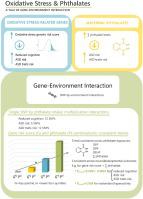NeuroToxicology ( IF 3.4 ) Pub Date : 2020-05-30 , DOI: 10.1016/j.neuro.2020.05.006 Anne-Louise Ponsonby 1 , Christos Symeonides 2 , Richard Saffery 2 , Jochen F Mueller 3 , Martin O'Hely 4 , Peter D Sly 5 , Nicole Wardrop 2 , Angela Pezic 2 , Toby Mansell 2 , Fiona Collier 6 , David Burgner 7 , Kristie Thompson 3 , Soumini Vijayasarathy 3 , Eva J Sugeng 8 , Terence Dwyer 9 , Sarath Ranganathan 2 , Peter J Anderson 10 , Vicki Anderson 2 , Peter Vuillermin 6 ,

|
Prenatal phthalate chemicals may have adverse effects on brain development by various mechanisms including oxidant damage. However, birth cohort findings have been conflicting. This study aimed to (i) investigate the interplay between maternal prenatal phthalate levels, infant genetic vulnerability to oxidative stress, and child neurodevelopment and (ii) examine combined putative oxidant exposures. In a population-based birth cohort of 1064 women with prenatal recruitment in Victoria, Australia, maternal urine was collected at 36 weeks of pregnancy and phthalate metabolite concentrations measured. An unweighted genetic score for oxidative stress was made using a candidate gene approach. Cognition was assessed using the BAYLEY-III at two years (n = 678). Parents completed questionnaires for doctor diagnosed autism spectrum disorder (ASD) (1.4 %), ASD traits (4.9 %) and child inattention/hyperactivity (n = 791). Analyses included multiple linear and logistic regression. Higher prenatal phthalate levels and a higher oxidative stress genetic score were each associated with subsequent ASD. Several oxidative stress-related SNPs modified the association between prenatal phthalates and ASD and other outcomes. Consistent patterns were evident across gene score-phthalate combinations for cognition, ASD, ASD traits and inattention/hyperactivity. Other putative oxidant factors such as prenatal smoking further increased risk. Prenatal phthalate levels and infant oxidative stress-related genetic vulnerability are associated with adverse neurodevelopment. Combined exposures are important. Current recommendations and regulation on maternal phthalate exposure during pregnancy require re-evaluation.
中文翻译:

产前邻苯二甲酸酯暴露,与氧化应激相关的遗传易感性和早期生命的神经发育:一项出生队列研究。
产前邻苯二甲酸酯类化学物质可能通过多种机制(包括氧化剂损害)对大脑发育产生不利影响。但是,出生队列的发现一直存在矛盾。这项研究旨在(i)研究孕妇产前邻苯二甲酸酯水平,婴儿对氧化应激的遗传易感性和儿童神经发育之间的相互作用,以及(ii)检查组合推定的氧化剂暴露量。在澳大利亚维多利亚州以人口为基础的1064名有产前招募妇女的出生队列中,在怀孕36周时收集了孕妇尿液,并测量了邻苯二甲酸酯代谢物浓度。使用候选基因方法对氧化应激进行了未加权的遗传评分。在两年(n = 678)时使用BAYLEY-III评估认知度。父母填写了针对医生诊断为自闭症谱系障碍(ASD)的问卷(1.4%),ASD特质(4.9%)和儿童注意力不集中/多动症(n = 791)。分析包括多元线性和逻辑回归。较高的产前邻苯二甲酸盐水平和较高的氧化应激遗传评分均与随后的ASD相关。几种与氧化应激相关的SNP修饰了产前邻苯二甲酸酯与ASD和其他结局之间的关联。在认知,ASD,ASD性状和注意力不集中/多动症的基因评分-邻苯二甲酸酯组合中,存在明显的一致模式。其他假定的氧化因素,如产前吸烟,则进一步增加了患病风险。产前邻苯二甲酸盐水平和婴儿氧化应激相关的遗传易感性与不良的神经发育有关。合并暴露很重要。当前有关孕妇孕期邻苯二甲酸酯暴露的建议和法规需要重新评估。











































 京公网安备 11010802027423号
京公网安备 11010802027423号